#la pallaresa
Text
La Masia: On Domestic And Territorial Care
The term mas refers to an agrarian and self-sufficient structure that emerged in the southern side of the Eastern Pyrenees between the XVIII and IX centuries. It continues to evolve today and was established during the military conflict between the Christian and Muslim kingdoms to organize and establish territorial borders.
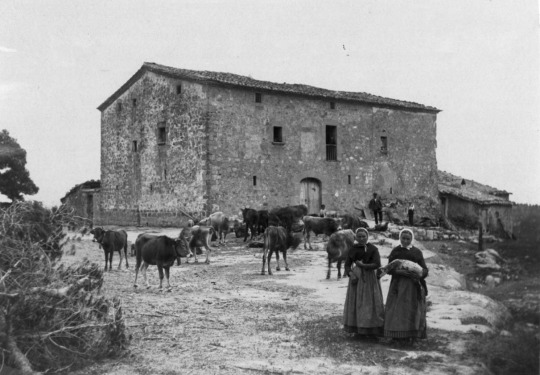
Women with a herd of bulls and cows in front of a farmhouse in Solsona | Photo © Lluís Vila i d’Abadal, Estudi de la Masia Catalana (C.E.C.)
The mas is characterized by closely intertwined spatial activities that create a distinct organization of living and working spaces. In households of peasants and lower-income families, the division between these activities was minimal or nonexistent, resulting in overlapping tasks that offset the traditional sexual division of labor.
The components of the mas facilitated the exploitation and maintenance of crops, orchards, livestock, and more. They also played a crucial role in shaping a new social structure, typically centered around one or several families, within a rural setting. The main inhabitable space at the heart of this complex is known as the "masía" or "farmhouse."
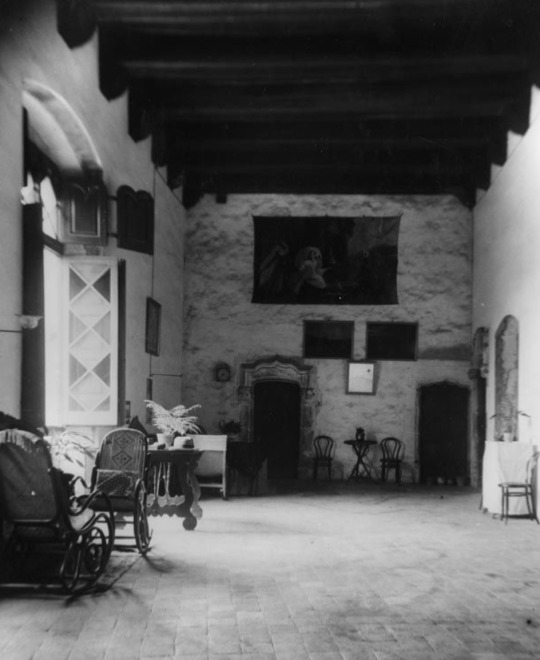
Interior of a "sala de la pallaresa" (main social room) in Santa Coloma de Gramenet. | Photo © Josep de Cabanyes, Estudi de la Masia Catalana (C.E.C.)
The masía, as an architectural typology, holds significance within this context as it represents a milestone in territorial repopulation strategy. It goes beyond domesticating nature and establishes a new social and economic system in previously uninhabited areas. To truly understand it, it is necessary to examine the architectural spaces that form this typology as a complex system of cohabitation between humans, non-humans, and nature. In the X, XI, and XII centuries, the initial settlements of these masías emerged along the stabilized borders of the Iberian territory. These locations were not primarily determined by geographical factors but rather by historical and social events that shaped a novel system of agricultural exploitation.
The house is internally organized into three spatial sections, separated by four sturdy masonry walls. These walls, sometimes as thick as one meter, are constructed using a mix of stone and soil materials. They provide support for the wooden beams that form the floors above. The construction system of the house follows a logical and coherent set of rules, emphasizing efficiency and functionality to accommodate all domestic activities under one roof.

Typological organisation of a Catalan Masia | Photo © self-office
On the ground floor, the three spatial sections typically consist of a central hall, flanked by the kitchen, stables, and cellar on either side. Moving to the upper floor, the central room serves as the primary living space and also functions as an entryway to the various rooms or bedrooms located on both sides. This central room holds great significance as it becomes the focal point of the house. It serves as a gathering space for communal activities, cultural ceremonies, and religious rituals, making it the most representative area of the entire dwelling.
In certain typologies, a third level exists, designed for permanent ventilation, providing an ideal space for drying clothes or hay by harnessing the natural winds that occur at that height. This section of the house exhibits some morphological variations, often standing apart from the main structure and possessing its own distinct identity within the overall complex. The formal expression of the "masía" has adapted to varying resources and construction systems over time while maintaining essential elements.
Following the second industrial revolution, particularly in Catalonia during the 1950s and 1960s, rapid economic growth led to a significant population increase, resulting in a mass migration from rural areas to urban centers. This shift had a profound impact on the local economies that relied on these longstanding agricultural structures. The traditional role of the Catalan Masia as a caretaker of the land and its productive essence gradually succumbed to a culture of mass consumption and the influence of a free market economy. Nowadays, many of these houses have been abandoned or sold as secondary residences, vacation homes, hostels, or restaurants, primarily driven by the speculative nature of the real estate market.
We find ourselves in a pivotal moment in history where vernacular architecture is reclaiming its significance in the architectural realm. Examining these typologies as low-tech structures holds immense potential for offering alternative solutions in response to the pressing climate crisis. Additionally, it enables us to restore our connection with nature as human beings.
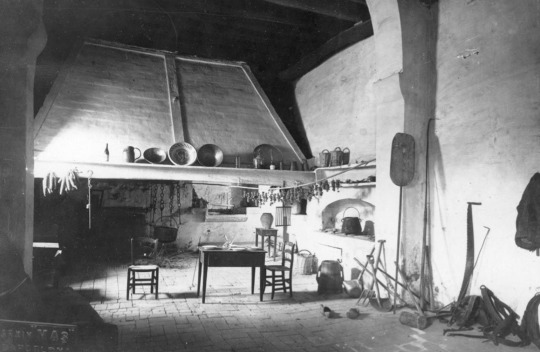
Kitchen with a floor fireplace in the Vilassar Castle, equipped with furniture, utensils, and tools. | Photo © Unknown, Estudi de la Masia Catalan (C.E.C.)
However, this metaphorical "return to the countryside" has historically emerged during periods when urban life becomes increasingly challenging and uncertain, and it is intertwined with a romanticized idealization of rural living. Thus, it is important to recognize this romantized idea should be balanced with a realistic understanding of the complexities and challenges of rural life. As we learn from vernacular architecture, we must adapt it to modern needs and achieve a certain balance between urban and rural settings.
Today, this nostalgia for the countryside coincides with new environmentalist political stances, increased global awareness of urban air quality issues, and a rising housing crisis in Western cities. The lack of public investment in housing makes it urgent to explore alternative living options for a generation facing ongoing instability. Recent changes in family structures, gender identities, work organization, and the impact of new technologies provide an opportunity to foster alternative households that can open up new territories and economies.
The Catalan Masia has the potential to bring about new socio-economic dynamics in neglected rural areas. Initiatives like housing cooperatives in these regions are already challenging the traditional model of individual property ownership. One notable example is the "El Turrós" project, created in 2021 by the organization "Sostre Cívic" to promote cooperative housing. The project goes beyond providing housing and becomes a collective effort that utilizes available rural spaces to generate social and economic value. This approach ensures that housing remains accessible and stable for community members and encourages sustainable practices such as local sourcing, waste reduction, and the development of small-scale businesses. This, in turn, nurtures a sense of interdependence and care among residents.
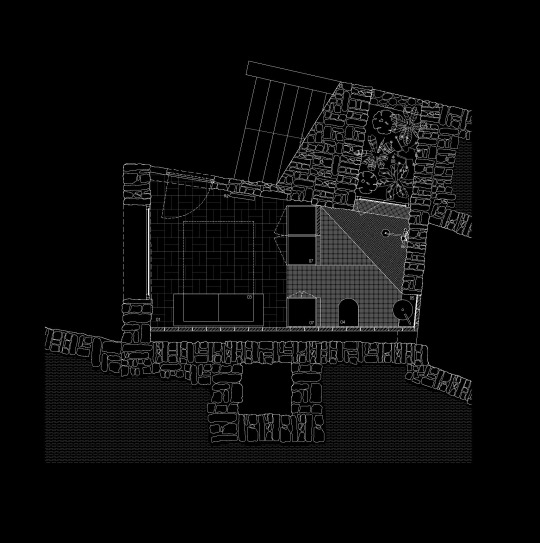
“La Nogareda” renovation project by self-office | Photo © self-office
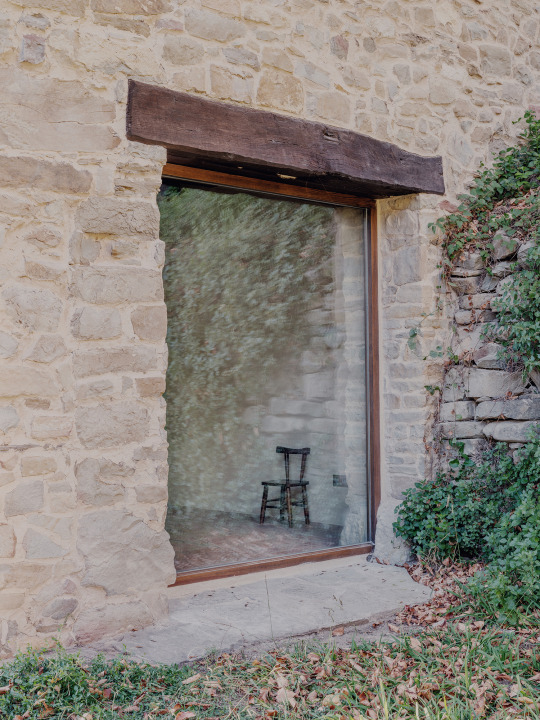
“La Nogareda” renovation project by self-office | Photo © Pol Masip
The revitalization of this architectural typology not only offers a multitude of possibilities for reclaiming traditional identities and forging new social structures but also provides an ideal setting to embrace ethics of care and sharing as a way of communal living. By reframing our perspective on the living environment through a care-oriented lens, we shift away from designing spaces solely based on functionality and instead emphasize the well-being of the individuals who occupy them.
As a practice, our first comissions have primarily involved working with these typologies. Since each project has very specific constraints, it became a great opportunity to develope new formal investigations and question established notions of domesticity.
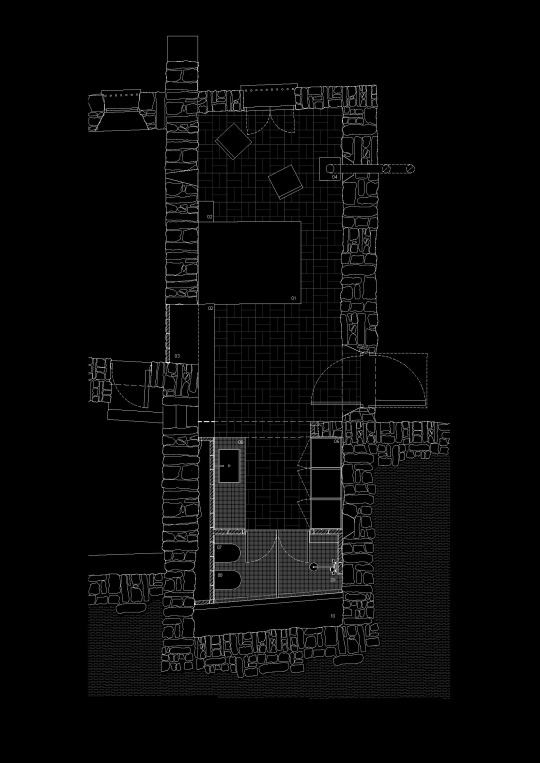
“La Nogareda” renovation project by self-office | Photo © self-office
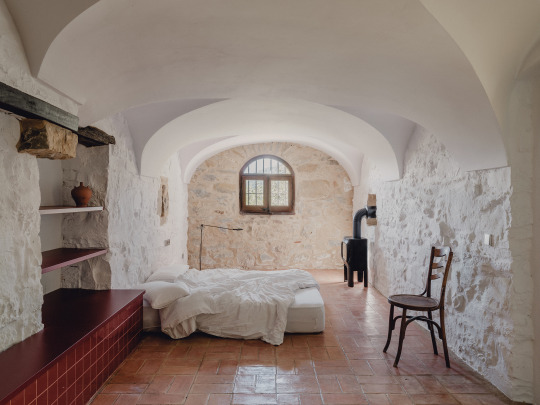
“La Nogareda” renovation project by self-office | Photo © Pol Masip
One of our first commissions involved transforming animal quarters into habitable rooms. The existing spaces presented peculiar proportions: one was unusually low in height but spacious, while the other was relatively tall but not spacious enough. Consequently, each space required distinct renovation strategies, and users were compelled to adapt their habits to the nature of the given space.
The potential of these uncertain spaces is highly significant, as they empower users to make more personalized decisions in establishing their domestic rituals and lifestyles. By actively engaging with the spatial possibilities presented by the Catalan Masia, users can cultivate a sense of ownership and connection to their unique preferences, values, and aspirations.
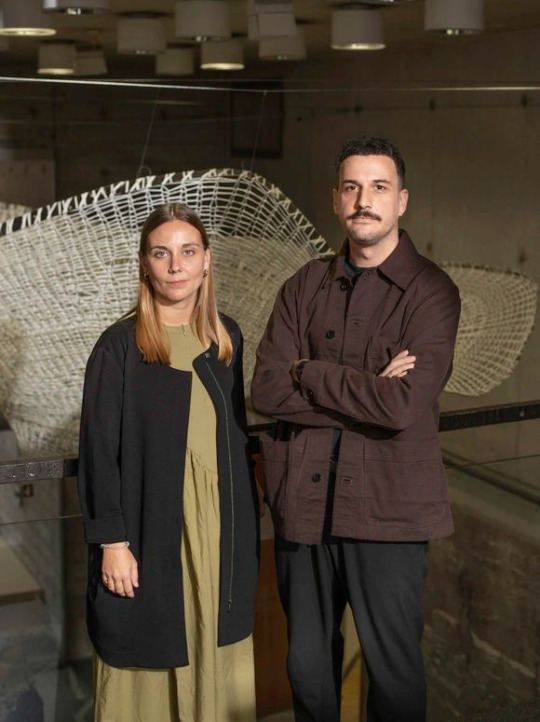
self-office are Laura Solsona and Eduard Fernandez. | Photo © Urban Cerjak
-
by self-office - Digital Architectuul Fellow of LINA.
#self-office#lamasia#catalanvernacular#territorialcare#domesticity#housingrenovation#cooperativehousing#countryside#rural
13 notes
·
View notes
Text
11a Fira de Vi del Pirineu - Talarn
Dies 9, 10 i 11 de juny del 2023 Talarn (Pallars Jussà)
A la Fira de Vi del Pirineu podeu gaudir de les diferents activitats que s’han programat que van des de les visites als cellers de la zona, passant pel sopar de Fira fins a la degustació de la gastronomia pallaresa i els vins dels cellers que hi seran presents.
MÉS INFORMACIÓ A: http://www.talarn.cat/
I A:…
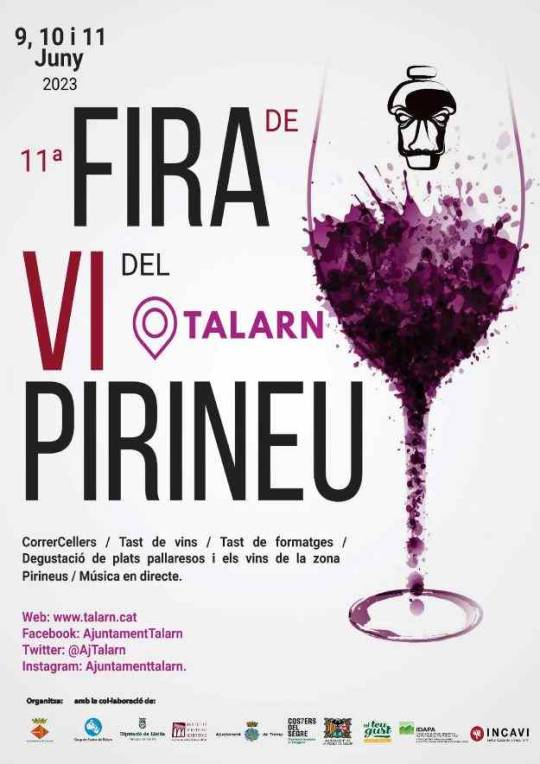
View On WordPress
0 notes
Photo









De Salses a Guardamar i de Fraga a l’Alguer: les comarques de parla catalana una a una. 11/88: el Pallars Jussà (High Pyrenees, Catalonia).
Pallars Jussà is a district in the Pyrenee mountains of Catalonia, around the course of the Noguera Pallaresa river. Its capital city is Tremp.
Like around some other rivers of the Catalan Countries, raiers used to make their simple boats made of birch tree, and in summer they sailed down the Noguera Pallaresa to sell the wood they collected in the Pyrenee mountains. This economic activity is no longer practised, but some people still learn to be raiers and every year there is a festivity that commemorates this old job where people make the rais (boats) and sail in the traditional way to la Pobla de Segur. That weekend there are also many concerts of traditional and modern music and fairs of typical food from the Pallars.
Like this whole area, there are many Medieval churches and villages, and the mountains are beautiful.
Photos from pallarsjussa.net, elsraiers.cat, vallfosca.net, wikimedia, fallairespobla, pnaiguestortes, and bcncatfilmcommision.com.
34 notes
·
View notes
Photo




Embassament de Sant Antoni (or Pantà de Talarn, Catalonia)
It´s easy to escape from bad weather in the high Pyrenees by travelling southbound. On our way, we stop and spend some time at this beautiful lake near La Pobla de Segur. From here we follow the river La Noguera Pallaresa to the Serra del Montsec, a mountain system of the Pre-Pyrenees.
#embassament#sant antoni#reservoir#lake#la pobla de segur#pantano#landscapes#pirineos#pyrenees#pyrenäen#catalunya#catalonia#talarn#noguera pallaresa
7 notes
·
View notes
Text
RoadTrip 04 - Journal de bord: J+3

Jour - J+3:
Réveillé par le cours de l'eau du fleuve Noguera Pallaresa, j'ai repris la route en direction de Perpignan. Mais avant d'y arriver. J'ai dû traverser de nombreux petits villages espagnols, chacune avec son charme.

Passant de paysages asséchés à des champs verdoyants, j'ai continué mon ascension alternant les champs et les montagnes.

J'ai également franchi de nouveaux cols montagneux. Me faisaient découvrir des points de vues magnifiques.


Je fus très surpris de voir que tous les villages que je traversais été vide d'occupant. Jusqu’à ce que je me rappelle que les après-midi en Espagne étaient dédiés à la sieste.

J'ai regagné la France en passant par le Col du Calvaire de Font-Romeu à 1836m Atl.

Après Font-Romeu, j'ai pris la direction de Perpignan, en prenant le plaisir de redescendre au niveau de la mer avec toujours ce même plaisir à prendre les virages.


C'est en fin d'après-midi que j'arrivais chez mon ami avec qui nous avons profité de faire un barbecue avant de rejoindre le confort d'un lit. Et oui, demain dernière ligne droite pour rejoindre la famille à Marseille.
0 notes
Photo

Viviendas La Pallaresa, Santa Coloma de Gramanet, Barcelona - Terradas arquitectos + Soto de Moura
3 notes
·
View notes
Photo

El Castillo de San Oïsme, declarado bien cultural de interés nacional en 1988, es una antigua y magnífica fortaleza románica del siglo XI, localizado en la Baronía de San Oïsme, Camarsa, Lleida. Destaca significativamente su impresionante torre de 14 metros, a unos 4 metros sobre el suelo, alzada en la cima de una roca, en el valle de la Noguera Pallaresa, y cuyas inigualables vistas, que incluyen el desfiladero de Terradets y el valle de Àger, son un verdadero regalo de la naturaleza para sus residentes y visitantes. ⠀⠀⠀⠀⠀⠀⠀⠀⠀ ... ⠀⠀⠀⠀⠀⠀⠀⠀⠀ The Castle of San Oïsme, declared a cultural asset of national interest in 1988, is an ancient and magnificent Romanesque fortress from the 11th century, located in the Barony of San Oïsme, Camarsa, Lleida. Significantly highlights its impressive 14 meter tower, about 4 meters above the ground, raised on top of a rock, in the Noguera Pallaresa valley, and whose unparalleled views, which include the Terradets gorge and the Àger valley, They are a true gift of nature for its residents and visitors. ⠀⠀⠀⠀⠀⠀⠀⠀⠀ ... ⠀⠀⠀⠀⠀⠀⠀⠀⠀ #otoño #autumn #otoño2019 #autumn2019 #turismo #turisme #tourism #turismorural #ruraltourism #arquitectura #architecture #torre #tower #BaroniadeSantOïsme #SantOïsme #SantOisme #camarsa #lerida #lleida #iglleida #installeida #poblescatalans #catalunya #cataluña #igcataluña #ig_catalonia #igcatalunya #españa #spain (en La Baronia De Sant Oïsme, Lleida) https://www.instagram.com/p/B5OGihRodRp/?igshid=xazbkv6m00km
#otoño#autumn#otoño2019#autumn2019#turismo#turisme#tourism#turismorural#ruraltourism#arquitectura#architecture#torre#tower#baroniadesantoïsme#santoïsme#santoisme#camarsa#lerida#lleida#iglleida#installeida#poblescatalans#catalunya#cataluña#igcataluña#ig_catalonia#igcatalunya#españa#spain
0 notes
Photo

Pantà de Camarasa El pantà de Camarasa és un embassament que pertany al riu Noguera Pallaresa. La presa fou construïda als anys 1920 per l'empresa Barcelona Traction, Light and Power Company Limited, coneguda com La Canadenca, i configura aquest embassament que s'estén al llarg de 20 km, des del Montsec fins a l'aiguabarreig del riu Noguera Pallaresa amb el Segre. . . . . #agrupaciofotograficadecatalunya #agrupaciofotocat #FedCatFoto #afosants #espaifotogràficcanbasté #kirowa #kirowa_foto #clikcat #fotodng #fotoline_es #catalunya_foto #miradzoom #instacat_club #cat_imatges #igerscatalunya #catalunyaexperience #raconsde_catalunya #catalunya_streets #cat_imatges #catalunyafotos #OK_catalunya #total_catalunya #catalunya #paisatges_de_catalunya #lleida #fotomensual_lleida #aralleida #ig_catalonia #catalunyaexperience #paisatges_de_catalunya (en Camarasa) https://www.instagram.com/p/B3aG6S_B9Fg/?igshid=g9fnhgvz2w5g
#agrupaciofotograficadecatalunya#agrupaciofotocat#fedcatfoto#afosants#espaifotogràficcanbasté#kirowa#kirowa_foto#clikcat#fotodng#fotoline_es#catalunya_foto#miradzoom#instacat_club#cat_imatges#igerscatalunya#catalunyaexperience#raconsde_catalunya#catalunya_streets#catalunyafotos#ok_catalunya#total_catalunya#catalunya#paisatges_de_catalunya#lleida#fotomensual_lleida#aralleida#ig_catalonia
0 notes
Photo

How to start a day in Barcelona: xocolata espesa amb xurros. Hot, very thick chocolate with churros. #barcelona #breakfast #xurros #xocolata #granja #catalan #esmorsar #foodporn #foodie #delicious #typical #oldtimes (hier: Granja La Pallaresa) https://www.instagram.com/p/B2MdhnNIFlf_0OtU1VmWG2gCLfdX0nltbjD71c0/?igshid=1asklqvooaj6v
#barcelona#breakfast#xurros#xocolata#granja#catalan#esmorsar#foodporn#foodie#delicious#typical#oldtimes
0 notes
Photo

Today I’ve spent the afternoon rafting down the river Noguera Pallaresa, in the Catalan Pyrenees. The landscape is just astonishing, and going through the gorge has been an amazing experience. Apparently the famous Catalan architect Antoni Gaudí, got here inspired to design the Sagrada Familia. 🙌 😍 ☀️ 🌊 ⛰ 🛶 📸 #pirineuscatalans #lleida #noguerapallaresa #catalunyaexperience #catalunya_natura #catalanpyrenees #cañon #muntanyes #mountains #river #riu #rio #picoftheday #naturephotography #photooftheday #travelphotography #exploretheworld #theworldisyouroyster #getlostwithme #pierdeteconmigo #igerslleida #paisajesnaturales #paissatgesdecatalunya (at Gerri De La Sal, Cataluna, Spain) https://www.instagram.com/p/Bz6Zz6MoBkJ/?igshid=1qfmc8f1lup3j
#pirineuscatalans#lleida#noguerapallaresa#catalunyaexperience#catalunya_natura#catalanpyrenees#cañon#muntanyes#mountains#river#riu#rio#picoftheday#naturephotography#photooftheday#travelphotography#exploretheworld#theworldisyouroyster#getlostwithme#pierdeteconmigo#igerslleida#paisajesnaturales#paissatgesdecatalunya
0 notes
Photo

L’espai on es vol realitzar la mina de Salau, fins i tot en la fase d’investigació i sondejos, resultaria de forma permanent afectada i contaminada en tots els seus aspectes naturals, riquesa hídrica, biodiversitat i paisatge. Pel que fa a la importància hídrica, la zona afectada forma part de la capçalera de la Noguera Pallaresa, riu que fins ara es considera el més ben conservat de Catalunya. Convé denunciar que el programa de treball presentat per Neometal no adverteix que l’activitat investigadora prevista pels primers 12 mesos afecta greument el subsòl. The space where Salau mine wantes to be performed, even in the research and surveying phase, It would be permanently affected and contaminated in all its natural aspects, water wealth, biodiversity and landscape. Regarding the water importance, the affected area is part of the head of the Noguera Pallaresa, a river that until now is considered the best preserved in Catalonia. Furthermore, the work program submitted by Neometal does not warn the activity researcher planned for the first 12 months that, seriously, affects the subsoil. El espacio donde se quiere realizar la mina de Salau, incluso en la fase de investigación y sondeos, resultaría de forma permanente afectada y contaminada en todos sus aspectos naturales, riqueza hídrica, biodiversidad y paisaje. En cuanto a la importancia hídrica, la zona afectada forma parte de la cabecera de la Noguera Pallaresa, que hasta ahora se considera el mejor conservado de Cataluña. conviene denunciar que el programa de trabajo presentado por Neometal no advierte que la actividad investigadora prevista por los primeros 12 meses afecta gravemente al subsuelo. https://www.instagram.com/p/ByAboqbIiPW/?igshid=19xqsipj4lydl
0 notes
Photo

La Noguera Pallaresa (Catalonia)
We´re back in the high Catalonian Pyrenees and set up our camp at the river Noguera Pallaresa near Llavorsí. This is our home base for excursions to the following destinations:
The Alt Pirineu Natural Park
The civil war memorial sites Pedres d´Auló and la Crestelleta
Locations of Jaume Cabré´s novel Les veus del Pamano (Die Stimmen des Flusses, German)
#noguera pallaresa#river#riu#rio#llavorsí#alt pirineu#natural park#Spanish civil war#jaume cabré#les veus del pamano#die stimmen des flusses#novel#camping#hiking#pyrenees#pirineos#pyrenäen#catalonia#spain#travel
95 notes
·
View notes
Text
Los 'raiers' catalanes apoyan una candidatura europea para ser Patrimonio de la Unesco
Los ‘raiers’ catalanes apoyan una candidatura europea para ser Patrimonio de la Unesco
EUROPA PRESS
LLEIDA, 10 (EUROPA PRESS)
Las dos asociaciones de ‘raiers’ (almadieros) de Catalunya -la de Ribera del Segre y la de la Noguera Pallaresa (Lleida)- apoyarán una candidatura europea para que su oficio sea declarado Patrimonio de la Humanidad por la Unesco, han informado ambas asociaciones a Europa Press este sábado.
Según ha explicado a Europa Press el presidente de la Asociación de…
View On WordPress
0 notes
Photo

Granja La Pallaresa. Carrer Petritxol. Barcelona. (en Granja La Pallaresa) https://www.instagram.com/p/BqwG_w9gbF9/?utm_source=ig_tumblr_share&igshid=1dyln398m585x
0 notes
Link
0 notes
Photo

8a Fira de Vi del Pirineu – Talarn Dies 8, 9 i 10 de juny del 2018 Talarn (Pallars Jussà) A la Fira de Vi del Pirineu podeu gaudir de les diferents activitats que s'han programat que van des de les visites als cellers de la zona, passant pel sopar de Fira fins a la degustació de la gastronomia pallaresa i els vins dels cellers que hi seran presents. MÉS INFORMACIÓ A:
0 notes